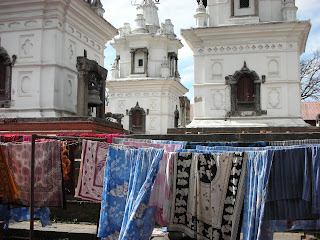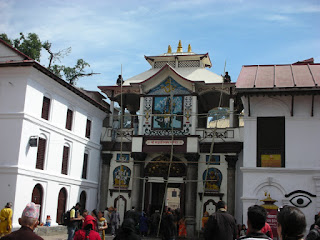Pashupatinath is known for its Pashupatinath Temple, where thousands of Hindus flock to give offerings to Shiva. The Temple was built in 1696, in pagoda-style. Only Hindus are allowed to enter the Temple; however, views are available from the outside and from across the Bagmati River.

From the entrance to the Temple, you can see the sacred rump of Nandi, Shiva’s bull.

There is also supposedly a six-foot Shivalinga shrine inside the Pashupatinath Temple, where devotees leave offerings of sacred water, honey, and milk. We weren’t able to view the actual shrine, but we did see a smaller replica in a nearby area.
In addition to a site to worship Shiva, Pashupatinath is also a Hindu cremation area. All along the Bagmati River, both in front of the Temple and for quite a distance further south, are cremation ghats, or raised stone platforms used for open-air cremations.

It is considered an honor to be cremated near Pashupatinath, and there is even a Hospice Home directly next to Pashupatinath, where the elderly wait to pass away and be cremated along the Bagmati River.

While this may seem strange to those of us who do not practice the Hindu faith, it is considered very important within the Hindu religion. Bodies are shrouded in colorful cloth and first dipped (feet and head) in the Bagmati River, which is felt to purify those who have passed away. They are they taken to the cremation ghats, where the bodies are placed upon large pyres which are lit by the eldest son in the family. After the cremation, solid remains are collected and buried along the Bagmati River; the remainder of the ashes are swept in to the River.

According to Hindu belief, this method of burial is considered to be completely holistic, returning the body back to its basic five elements – earth (burial of solid remains), fire (cremation), wind (ashes scattered during cremation), water (ashes placed in Bagmati River), and sky (smoke from cremation).
While it may seem unusual, or even uncomfortable, to visit a cremation grounds, it is an amazing cultural opportunity and a time to contemplate one’s own life and death. There are many other gorgeous sites to see around Pashupatinath.


Throughout the Temple area, there are many sadhus who, for a small contribution (baksheesh), will either bless you with a tika or pose in a picture.

Sadhus are Hindu devotees who have left their homes, jobs, and families, and embarked on a spiritual search. They are usually dressed in bright orange, covered in dust, and characterized by their very long, dread-locked hair and colorful face paintings.

They often place a tika on both Nepalis and foreigners. A tika is a symbol of blessing from the gods, worn by both men and women in the center of the forehead. It represents the all-seeing, all-knowing third eye, as well as being considered an important energy point. It is considered a sign of protection for those receiving the tika. In addition to the sadhu, there is also the Panch Deval (Five Temples) nearby Pashupatinath Temple. This is a former temple complex, which is now located within the confines of a social welfare center for the elderly.




These are such beautiful places. I can't wait to see them! Wonderful descriptions too, babe.
ReplyDelete